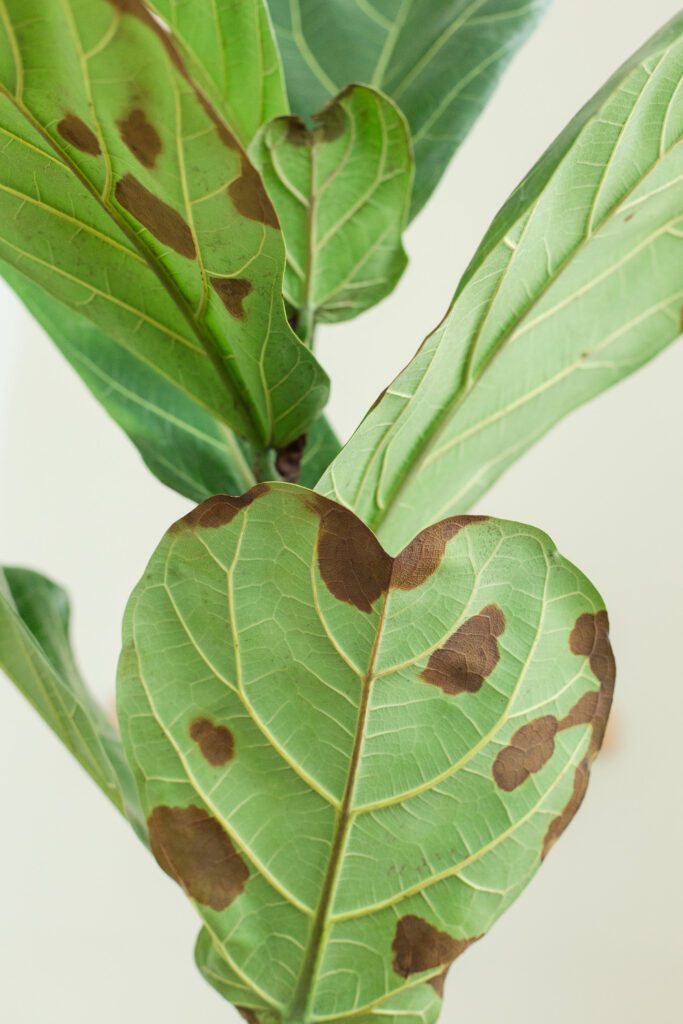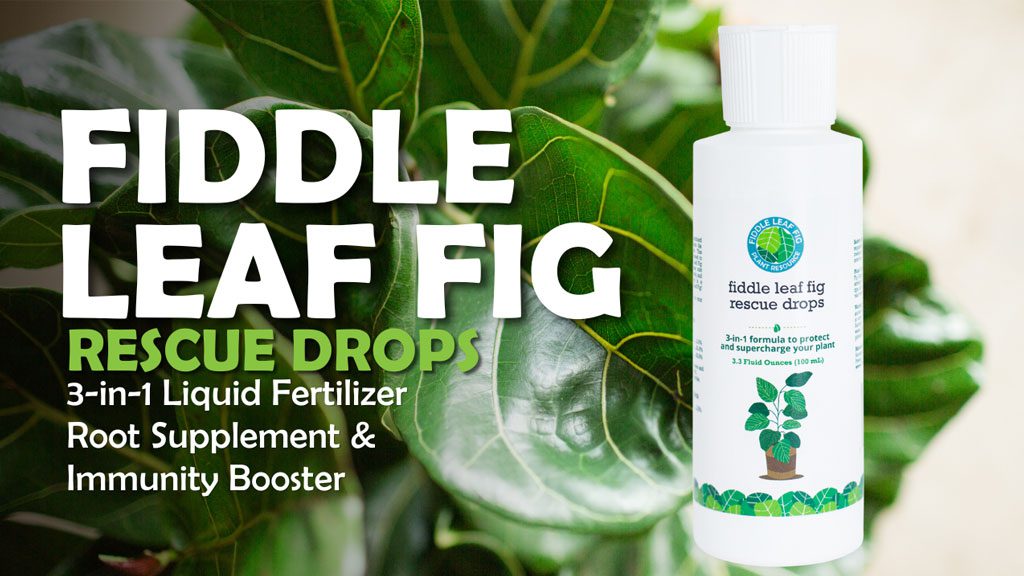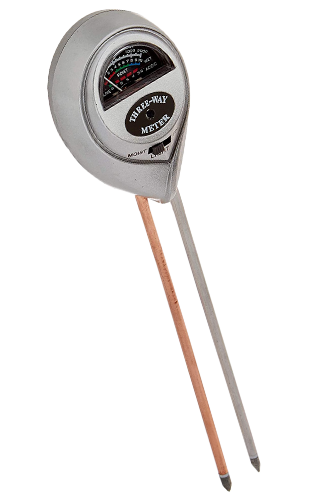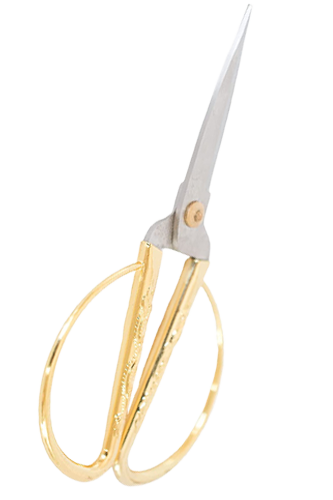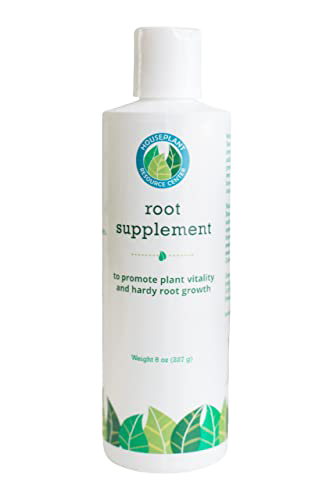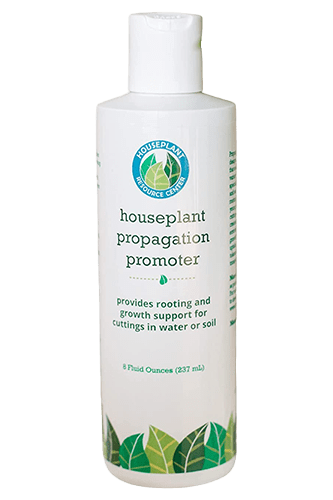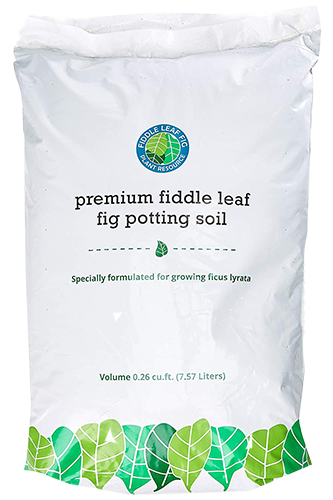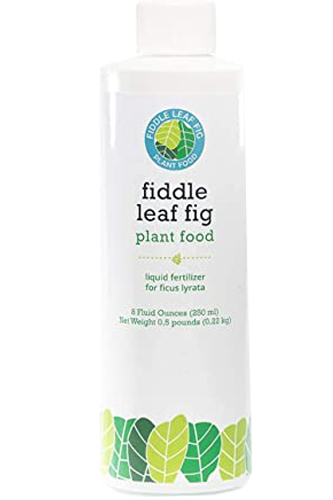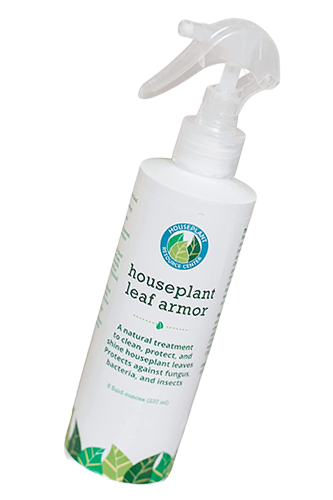Mimicking the native tropical rainforest environment of the fiddle leaf fig plant is vital to keeping it healthy. However, creating the perfect growing conditions isn’t always easy and often causes brown spots on fiddle leaf fig leaves.
Fortunately, these unsightly blemishes have many solutions to their various causes. Check out what’s causing brown spots on your fiddle leaf fig leaves and learn my secrets to keeping your plant happy, healthy, and looking its best.
Why Do My Fiddle Leaf Fig Leaves Have Brown Spots?
The exact cause of brown spots on a fiddle leaf fig varies greatly, and the best solutions start by asking yourself the following questions the moment you notice blemishes on the leaves:
- Is the spotting happening from the edge of the leaves out or the center in?
- Are they very dark brown spots or a lighter shade of brown?
- Is there just one spot, or are there many?
- Are the affected leaves falling off after brown spots appear?
- Are newer leaves near the top or older leaves near the bottom affected?
The answers to these questions can give you a better understanding of which solution(s) you’ll need to implement. Be aware that it isn’t uncommon to have several factors contributing to brown spots, so don’t be afraid to combine solutions until you find the right balance.
Brown Spots on Fiddle Leaf Fig Leaves: Causes and Solutions
Overwatering
When brown spots form in the middle of fiddle leaf fig leaves and work their way out towards the edges, chances are you have an overwatering issue. This issue is common as growers try to maintain the moisture-rich environments where the fiddle leaf fig naturally grows.
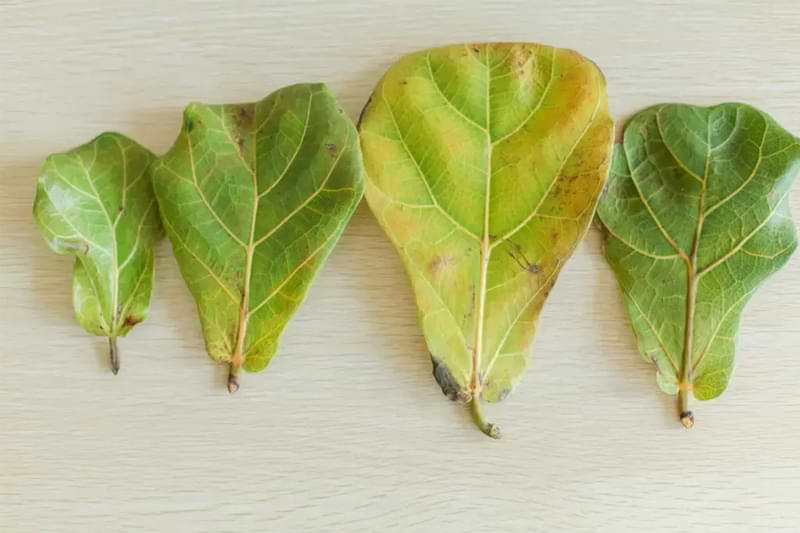
Additionally, signs that verify overwatering issues include yellowing and/or dropping leaves and muddy soil. If these signs aren’t present in combination with brown spots on the middle and edges of your fiddle leaf fig leaves, consider using a fiddle leaf fig moisture meter to check if the soil is oversaturated.
Because many factors contribute to overwatering problems, you’ll need to do a few different things to treat it:
- Let the top few inches of soil dry out before attempting any other fixes
- Check that the soil is well draining. Water should run through it quickly and easily.
- Repot with a specialty Fiddle Leaf Fig soil containing coco coir, perlite, and aged bark
- Stick to watering routine of once weekly ( 1 cup water per foot ensuring it drains well out the bottom)
A fiddle leaf fig might take a few weeks to recover from overwatering. Signs of recovery include healthy new leaf growth, a firm waxy leaf texture, and no more brown spots. Be sure to prune affected or dying leaves off the plant to help facilitate faster, healthier growth.
Underwatering
Brown spots that start at the edges of leaves and work their way inward are a common sign of underwatering. This is often a problem for growers in humid environments as they assume the plant is getting more water than it actually is.
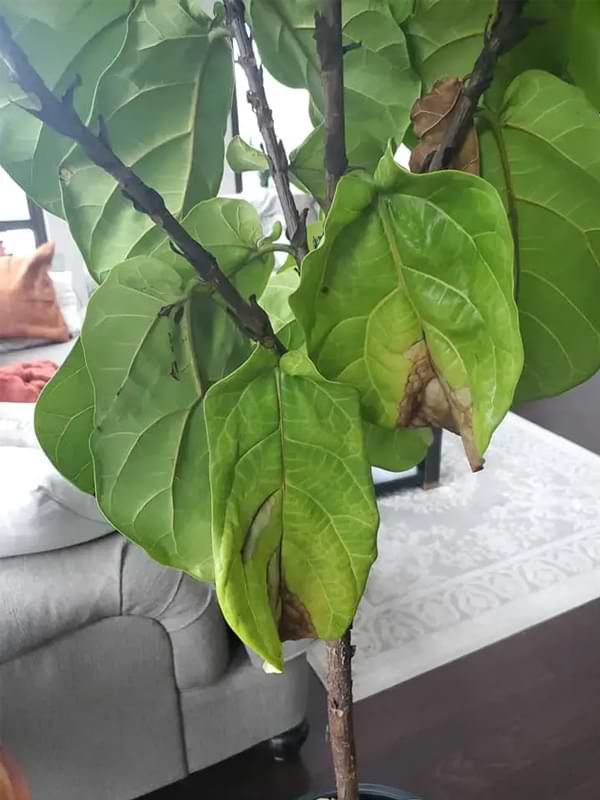
Other signs that typically accompany underwatering brown spots include crispy leaves, a droopy appearance, and dry soil.
To mitigate brown spot issues related to underwatering, you’ll need to implement one or more of the following fixes:
- Make sure the top four inches of soil is being moisturized during watering
- Increase ambient humidity with a mister, pebble tray, or humidifier
- Repot with a high-quality Fiddle Leaf Fig soil containing moisture-retentive ingredients
- Stick to a consistent watering schedule of 1 cup per two feet once weekly
- Water consistently until new healthy leaf growth occurs
Like with overwatering, you’ll also need sharp pruning shears to cut away old leaves that take up the plant’s energy. Signs of recovery include flexible leaf texture, deep green coloring, and no new brown spots.
Nutrient Deficiency
Like most houseplants, the fiddle leaf fig requires a balance of nutrients to thrive. Often, when the plant isn’t getting enough phosphorus, you’ll notice brown spots around the edges of the leaves. While this can look like an underwatering issue, it’s a tell-tale sign of nutrient deficiency if an overall yellowing of the whole plant accompanies it.
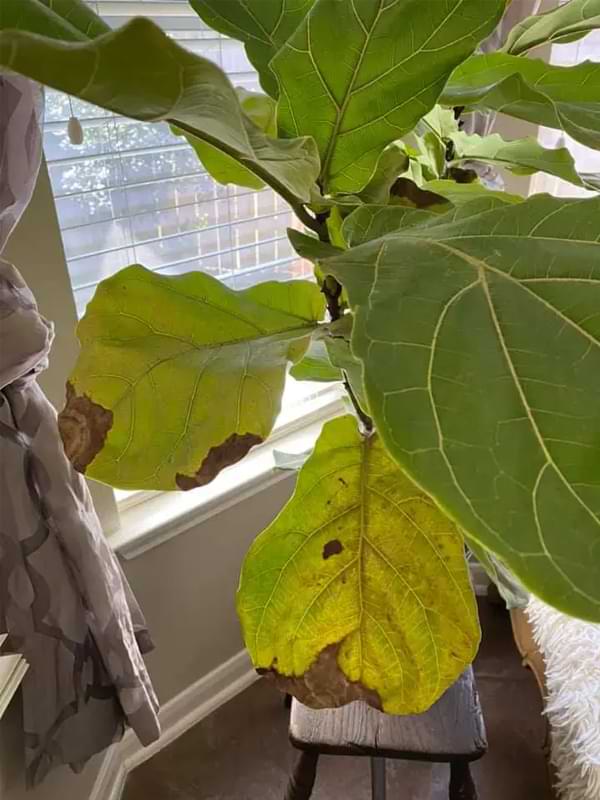
Nutrient deficiencies are among the easiest to fix, remedied quickly by including a liquid Fiddle Leaf Fig plant food into your watering routine. The ideal plant food will have a balance of nitrogen, phosphorus, and potassium with additional macronutrients.
Additionally, include a plant multivitamin every other week into your watering routine. This will help to replenish any other minerals and nutrients that may be missing in the soil or are severely lacking in the plant’s system.
Pests & Disease
Nothing ruins a fiddle leaf fig’s appearance faster than pests and diseases. Both can easily cause brown spots on leaves, branches, or the plant stem. The most common pest is likely mealy bugs, minuscule insects that feed on leaves and stems. They usually leave a sticky residue that easily attracts other pests and can result in black spots or mold growth.
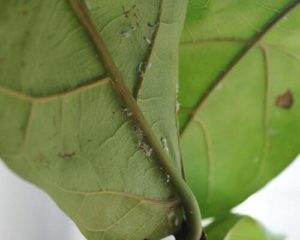
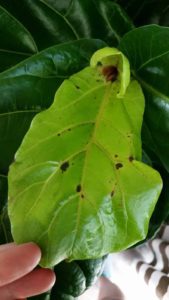
Other pests you may encounter include spider mites, aphids, and scales. Each has its own method of feeding on your plant, but all can leave behind brown spots as a key symptom.
Watering inconsistencies, poor lighting conditions, and low humidity typically cause disease issues. Brown spots that accompany disease issues can quickly spread and cause significant damage to your plant if not addressed promptly.
As with all other solutions, early detection is key for optimal outcomes. If you suspect pests or diseases, take the following measures to ensure rapid recovery and no more brown spots:
- Isolate the affected plant from any other houseplants
- Cut away any infected or dead leaves
- Use an organic pest control or fungicide such as neem oil
- Treat leaves with Fiddle Leaf Fig Leaf Armor for continued protection
- Incorporate Leaf Shine Spray into daily care and maintenance
- Return healed plant to setting with adequate air circulation & lighting; water consistently
Depending on the severity of the pest or disease issue, it may take several weeks for a fiddle leaf fig to fully recover. However, with proper treatment and care, your plant can thrive again without any unsightly brown spots.
Root Rot
As a result of overwatering, fungal infections, or poor soil conditions, root rot quickly causes brown spots on fiddle leaf fig leaves. The telltale signs of this deadly plant health issue will be black mushy roots, yellowing leaves, and brown spots that spread quickly – especially on older leaves. But you’ll have to pull the plant out of the pot and inspect the root systems to know for sure if this is the issue.
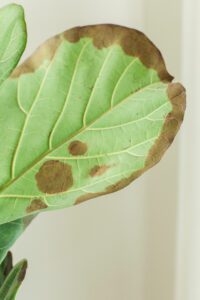
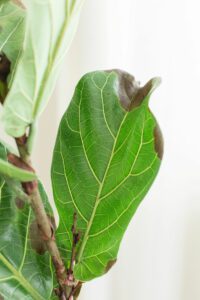
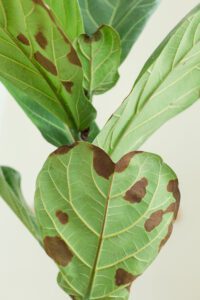
Treating root rot is a delicate process that requires sharp pruning shears, Fiddle Leaf Fig Root Supplement, and a fresh batch of premium soil. To begin:
- Carefully pull out the plant from its pot and inspect the root system
- Trim away any mushy or discolored roots with sharp pruning shears
- Treat cut roots with root supplement to facilitate new growth and stimulate root health
- Repot plant with fresh, premium soil that promotes healthy drainage
- Resume watering schedule of 1 cup per two feet once weekly
After a few weeks, you should start to see signs of recovery in the form of healthy green leaves without any brown spots. Continue to monitor your plant closely for any signs of recurring issues and adjust your watering and care routine accordingly.
Pro Tip: Read our Ultimate Fiddle Leaf Fig Watering Guide and learn how to avoid root rot and other moisture-related brown spot issues.
Fungal Root Rot Case Study
See photos of a plant with fungal root rot and watch as Claire, the Fiddle Leaf Fig plant expert shares her tips and tricks for saving it.
Bacterial Infection
Bacterial infections in plants are common and typically result from unsanitary conditions, poor ventilation, or over-watering. These infections can cause brown spots on the leaves and other symptoms like yellowing and wilting.
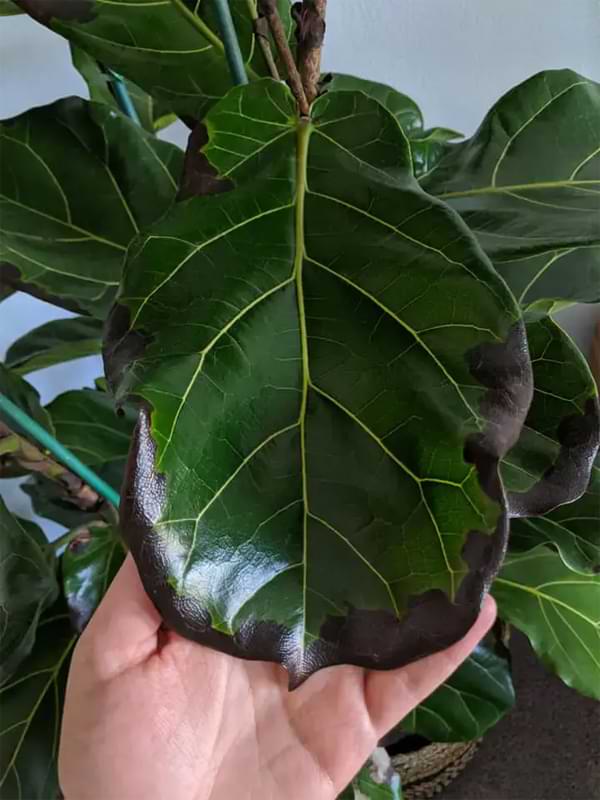
Keep your plant in a clean and well-ventilated environment to prevent bacterial infection. If you notice any signs of infection, immediately isolate the affected plant, treat it with organic bactericide, and incorporate a specialty root supplement, plant probiotic, and multivitamin into your watering routine to promote a strong and healthy immune system.
Dryness
Light brown spots or groupings of brown spots on leaves can be caused by dry air or heat stress resulting from less-than-optimal humidity levels. Brown spots from dryness are crunchy and will appear first on the oldest, most mature leaves. They also tend to have a more pox-like appearance rather than the large, single spots of root rot or bacterial infection.
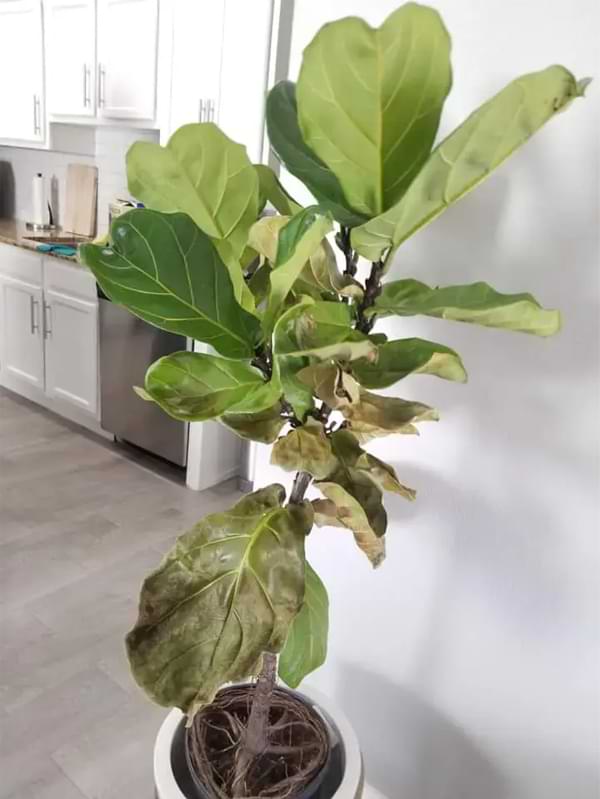
It is important not to confuse underwatering with brown spots from dryness. Unlike with root rot, plants suffering from dryness will show a general wilting or drooping of leaves while roots appear white and healthy.
To prevent your fiddle leaf fig from developing brown spots due to dryness, follow these steps:
- Keep humidity levels between 30-50% by misting leaves daily or using a humidifier
- Place the plant in a location with indirect, bright light
- Avoid placing the plant near heat sources such as radiators or air vents
- Keep plant away from drafts, air con, or areas with rapid temperature changes
Like all other solutions, you must prune away any damaged leaves and provide consistent care for your plant to thrive. With proper attention, your fiddle leaf fig will recover from dryness and prevent future brown spots from occurring.
Pro Tip: Use houseplant leaf shine wipes as part of a daily care routine to help keep your plant’s foliage clean and hydrated for optimal health.
FAQ: Causes of Brown Spots on Fiddle Leaf Fig Leaves
1. Is my big pot causing brown spots on fiddle leaf fig leaves?
The pot’s size may contribute to brown spots if it is too large for your plant. When a pot is too big, excess moisture can accumulate in the soil and cause root rot or other fungal infections.
Choosing a pot that is only 2-3 inches wider and a few inches taller than the original growing pot is essential. Additionally, the pot size should never exceed six inches in diameter for a mature fiddle leaf fig plant.
2. How do I know if my brown spots are caused by bacterial infection or root rot?
The key difference between bacterial infection and root rot is the speed at which the brown spots spread. Bacterial infection will typically progress more rapidly and cause more widespread damage, while root rot may take longer to develop but can still be deadly if left untreated.
If you suspect either issue, carefully inspect your plant’s roots and ask yourself if you have been overwatering or if the plant has been exposed to any extreme temperatures or moisture levels.
3. Will my brown fiddle leaf fig leaves turn back to green?
Once a leaf has turned brown, it will not turn green again. When leaves look dying, dead, or infected, the best solution is to prune them away to promote new growth and prevent the spread of any pests or diseases.
Make sure to cut away leaves at a 45-degree angle near the base of the stem and use sharp, sterile pruning shears to prevent any additional damage to the plant.
4. What is the ideal NPK ratio for fiddle leaf fig plants?
The ideal NPK ratio for fiddle leaf fig plants is 3:1:2, which means equal parts of nitrogen (N) and potassium (P), and slightly less phosphorus (K). This balanced ratio promotes healthy growth and prevents root rot or nutrient deficiencies.
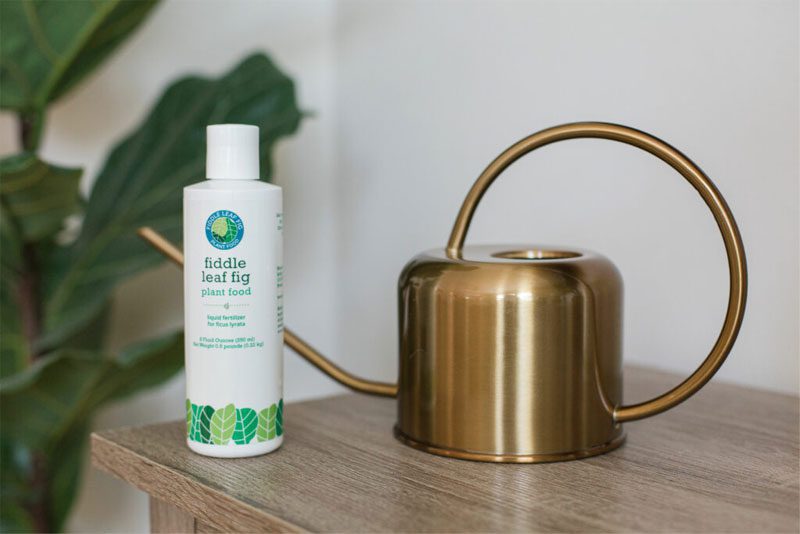
Using a fertilizer formulated explicitly for fiddle leaf figs is important, as this will provide the optimal balance of nutrients for your plant’s needs.
5. Are brown spots on a fiddle leaf fig always a sign of poor care?
Many things cause brown spots, so assessing your plant’s overall health and considering factors such as environmental conditions, watering schedule, and fertilizer use is important. While poor care can contribute to brown spots, other factors like spent leaves, natural plant aging, and active growing cycles may also be at play.
Your best bet to ensure optimal health for your fiddle leaf fig is to closely monitor plant health, maintain consistent watering, and incorporate proper fertilization into your care routine.
Essential Tools to Fight Brown Spots on Fiddle Leaf Fig Leaves
- Premium Fiddle Leaf Fig Potting Soil – Made with the perfect blend of nutrients and components to promote healthy growth and prevent root rot.
- Fiddle Leaf Fig Plant Food – Perfectly balanced NPK ratio and convenient measuring.
- Root Rot Treatment – Heals and restores root health for plants suffering from root rot and other fungal infections.
- Houseplant Leaf Armor – Natural solution that creates a protective layer on leaves to prevent pests and diseases.
- Houseplant Leaf Shine Spray – Fortified with natural ingredients that restore shine and health to leaves while providing a protective barrier against harmful elements.
- Moisture Meter – The perfect way to maintain consistent watering and avoid moisture issues that lead to brown spots on fiddle leaf fig leaves.
- Ultimate Fiddle Leaf Fig Care Bundle – Everything needed to keep your fiddle leaf fig healthy and thriving, including specialty potting soil, fertilizer, root rot treatment, leaf armor, and a moisture meter.
Keep Your Fiddle Leaf Fig Happy, Healthy, and Spot-Free!
Brown spots on fiddle leaf fig leaves aren’t just unsightly; they can also indicate underlying issues that require attention. By incorporating the essential tools and techniques discussed in this guide into your care routine, you can ensure that your fiddle leaf fig stays happy, healthy, and spot-free for years of enjoyment. Happy growing!
Learn More About Fiddle Leaf Fig Care & Maintenance
- Subscribe to the Fiddle Leaf Fig newsletter and never miss out on the latest products, deals, and care tips for your beloved plant.
- Enroll in our free Fiddle Leaf Fig Care 101 Webinar and Fiddle Leaf Fig Course packed with advanced care strategies and expert growing tips.
- Join our exclusive Fiddle Leaf Fig Plant Online Community and connect with other plant lovers dedicated to the care and growth of these beautiful houseplants.
- Order The Fiddle Leaf Fig Expert. This comprehensive FLF care guide available in full-color paperback and Kindle formats guarantees you’ll be a plant whisperer in no time.

